| id | Collection | Inventory n. | Name of the instrument | Maker | Place of manufacture | Dating | description | signature | dimensions | material | condition | maker_info | references | comments | fig_1 | fig_2 | fig_3 | fig_4 | fig_5 | fig_6 | fig_7 | fig_8 | fig_9 | fig_10 | |
|---|---|---|---|---|---|---|---|---|---|---|---|---|---|---|---|---|---|---|---|---|---|---|---|---|---|
| id | Collection | Inventory n. | Name of the instrument | Maker | Place of manufacture | Dating | description | signature | dimensions | material | condition | maker_info | references | comments | Image | fig_1 | fig_2 | fig_3 | fig_4 | fig_5 | fig_6 | fig_7 | fig_8 | fig_9 | fig_10 |
| 1 | Antonín Buchtel’s collection of musical instrument | E 427 | KIT (POCHETTE) + BOW | Anonymous | unknown | 18th century | Kit violin: The violin-shaped body is arched. The two-piece top plate is spruce, and the one-piece back plate and ribs are flamed maple. The rib for the lower bouts is made of a single piece of wood. The neck is fitted to the instrument in the Baroque manner. At the end of the neck, the peg box has a scroll that twists around three times. There are two F-holes and four strings (one steel not original, three gut). The fingerboard, tailpiece, and four tuning pegs are made of ebony. The end button is apparently made of dark varnished pear wood. The tilt of the fingerboard is set by a wedge (made of maple). There is only a hint of painted purfling.Bow: The rounded stick is made of brazilwood. The tip lacks a bone plate. The ivory frog is of the older type without a bottom moulding and without inlaid decorations. The head of the screw is made of ivory. The horsehair is white. | Kit violin:total length: 455 mmbody length: 179 mmbody width: upper 87 mm, middle 61 mm, lower 106 mmrib height: at the neck joint 18 mm, in the middle 17.5 mm, at the endbutton 18 mmstring length: 290 mmneck stop length: 195 mmbody stop length: 95 mmfingerboard length: 241 mmtotal length of soundholes: 40.5 mmupper span of soundholes: 20 mmBow:total stick length: 384 mm height (frog + stick): 26 mmstick diameter: 8 mm at the frog, 7 mm in the middle, 6 mm at the tip | spruce (top plate), maple (back plate, ribs), ebony (fingerboard, tuning pegs, tailpiece), pear wood (end button), nacre (middle of the end button), brazilwood (bow stick), metal (tailgut), horsehair, ivory (frog, bow screw), gut (strings) | Lower right rib set at a height of ca. 35 mm. Tailgut not original. One steel string not original. | Unpublished: ANM-RNM: carton 27, 1873–1874, delivered 31 May 1874, no. 63 (letter, Antonín Buchtel to the Committee of the Museum of the Kingdom of Bohemia, 22 May 1874); NM-ČMH: J 2208, J 2209 (historical negatives of the instrument).Published:[ROZKOŠNÝ, J. R.]: P. Antonína Buchtla vzácná sbírka hudebních nástrojů. Hudební listy, 1872, Vol. 3, No. 17, pp. 138–140; ŽŮRKOVÁ, Tereza – KOTAŠOVÁ, Daniela – ŠTEFANCOVÁ, Dagmar – SLAVICKÝ, Tomáš: Antonín Buchtel, sběratel s laskavou duší, a jeho kolekce hudebních nástrojů / Antonín Buchtel, A Collector with a Kind Soul, and His Collection of Musical Instruments. Praha: Národní muzeum, 2021. | The instrument was on display at the 7th Industrial Exhibition in Prague in 1872 and probably also at the World Exhibition in Vienna in 1873. | 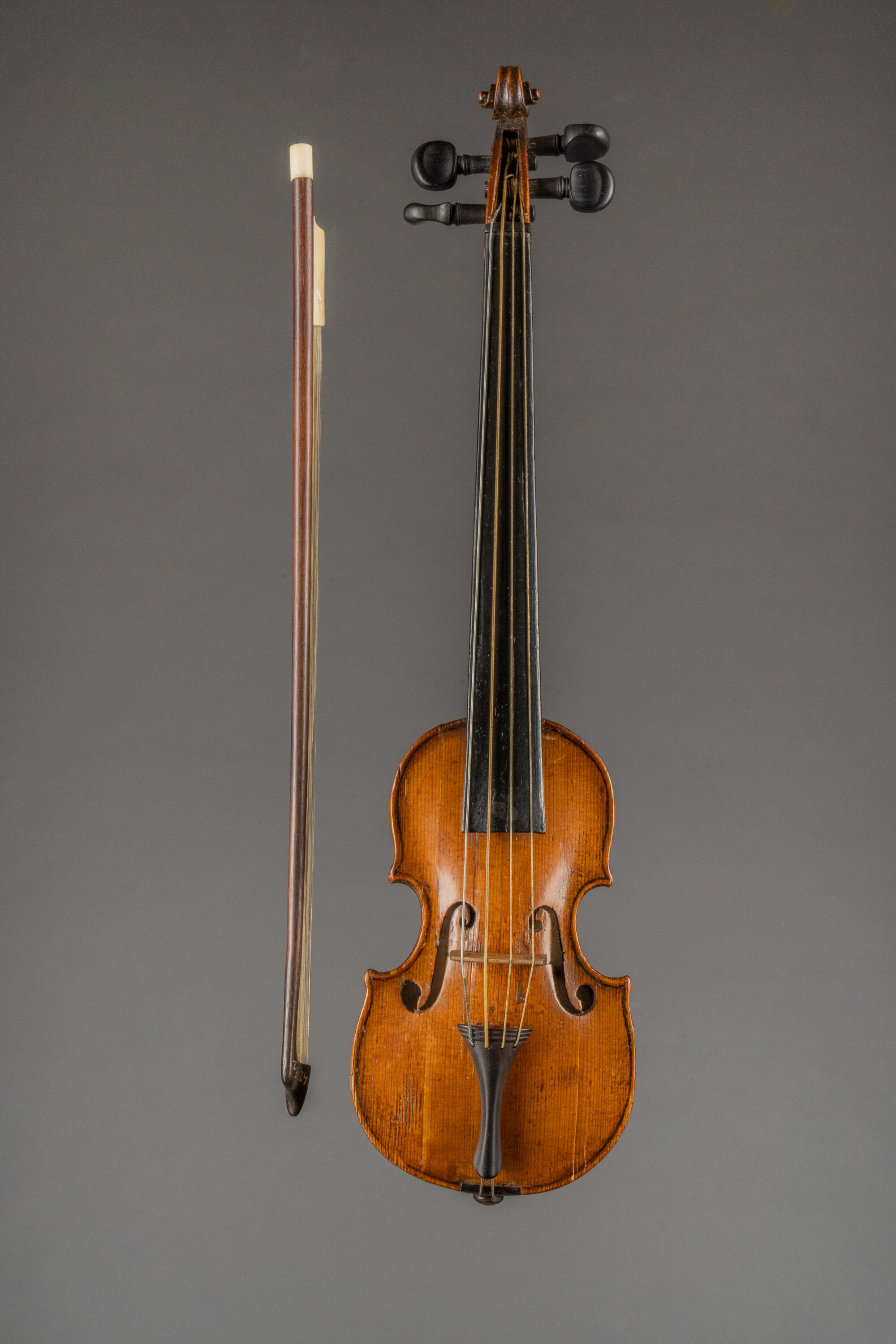 |
https://hudebninastroje.nm.cz/img/E_427-preview-1.JPG | https://hudebninastroje.nm.cz/img/E_427-preview-2.JPG | https://hudebninastroje.nm.cz/img/E_427-preview-3.JPG | https://hudebninastroje.nm.cz/img/E_427-preview-4.JPG | https://hudebninastroje.nm.cz/img/E_427-preview-5.JPG | https://hudebninastroje.nm.cz/img/E_427-preview-6.JPG | https://hudebninastroje.nm.cz/img/E_427-preview-7.JPG | https://hudebninastroje.nm.cz/img/E_427-preview-8.JPG | https://hudebninastroje.nm.cz/img/E_427-preview-9.JPG | https://hudebninastroje.nm.cz/img/E_427-preview-10.JPG | ||
| 2 | Antonín Buchtel’s collection of musical instrument | E 434 | KIT (POCHETTE) + BOW | Anonymous | unknown | 18th century | Kit violin: The body (in the shape of a figure eight) has no corners. The top plate is spruce, and the back plate, ribs, and neck are made of one piece of maple. The top plate does not extend beyond the ribs. The neck and fingerboard are massive. The tilt of the fingerboard is set by a wedge (made of maple). The soundholes are in the shape of the letter C. The tailpiece is made of ebony and is connected directly to the bottom part of the ribs, on which there is an ebony saddle. At the end of the peg box is a circular button with ivory at the centre. The nut is made of white bone. There are four gut strings and four tuning pegs. On the top and back plates there is poplar purfling.Bow: The round stick is made of pernambuco. The frog mounting without a screw mechanism was typical of bows of the 17th century (“ClipIn Frog” or “Slot-Notch”). However, in view of the material used (pernambuco), later dating should be considered (late 18th century or early 19th). The stick is only slightly concave, and the tip still has an extended shape, but with a somewhat higher arch (“swan head”). | Kit violin:total length: 345 mmbody length: 130 mmbody width: upper 55 mm, middle 50 mm, lower 65 mmrib height: at the neck 21 mm, in the middle 8 mm, at the end button 9 mmstring length: ca. 214 mmneck stop length: 147 mmbody stop length: ca. 67 mmfingerboard length: 183 mmtotal length of soundholes: 33 mmupper span of soundholes: 32 mmBow:total stick length: 395 mmheight (frog + stick): 24 mmstick diameter: at the frog: 7 mm, in the middle 6 mm, at the tip 5 mm | spruce (top plate), maple (back plate, ribs, neck), ebony (tailpiece, fingerboard, saddle), poplar (purfling), white bone (middle of the end button, nut), pernambuco (bow stick), boxwood (frog of the bow), horsehair, gut (strings) | Unpublished:ANM-RNM: carton 27, 1873–1874, delivered on 31 May 1874, no. 63 (letter, Antonín Buchtel to the Committee of the Museum of the Kingdom of Bohemia, 22 May 1874);NM-ČMH: J 2413, J 2210, J 2211 (historical negatives of the instrument).Published:BUCHNER, Alexander: Průvodce výstavou České hudební nástroje minulosti v břevnovském klášteře sv. Markéty. Praha: Národní muzeum, 1950, p. 59;CULKA, Zdeněk – RUTOVÁ, Milada – ŠERÝCH, Jaroslav: Muzeum hudebních nástrojů. Katalog stálé expozice hudebních nástrojů hudebního oddělení Národního muzea v Praze. 2nd edition, Praha: Národní muzeum, 1973, p. 25;NERMUT, Vít: Historical Bows in the Collections of the Czech Museum of Music. Galpin Society Journal, 2019, vol. 72, pp. 123–130, here pp. 124, 127, 128, 130;ŽŮRKOVÁ, Tereza – KOTAŠOVÁ, Daniela – ŠTEFANCOVÁ, Dagmar – SLAVICKÝ, Tomáš: Antonín Buchtel, sběratel s laskavou duší, a jeho kolekce hudebních nástrojů / Antonín Buchtel, A Collector with a Kind Soul, and His Collection of Musical Instruments. Praha: Národní muzeum, 2021. | 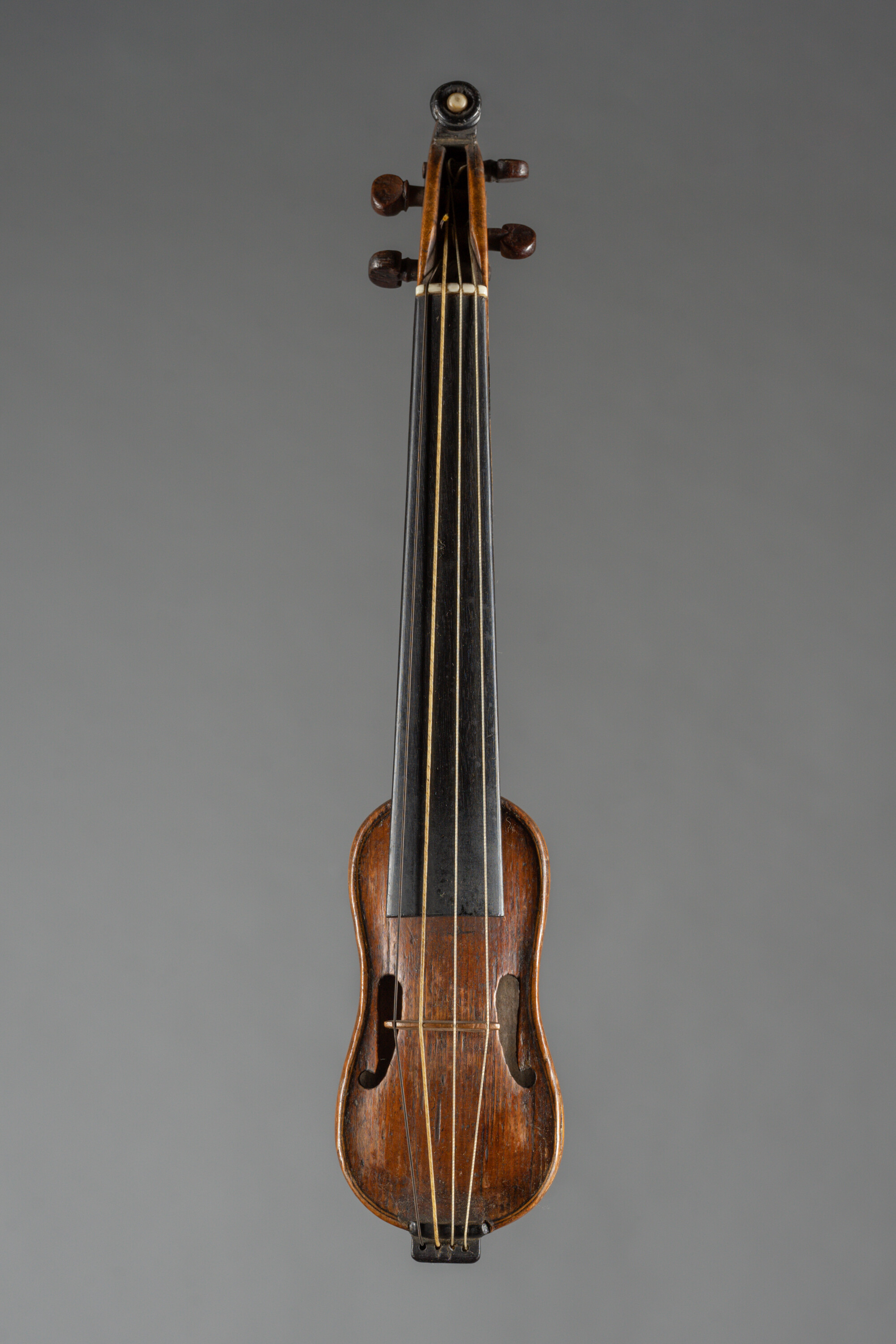 |
https://hudebninastroje.nm.cz/img/E_434-preview-1.jpg | https://hudebninastroje.nm.cz/img/E_434-preview-2.jpg | https://hudebninastroje.nm.cz/img/E_434-preview-3.jpg | https://hudebninastroje.nm.cz/img/E_434-preview-4.jpg | https://hudebninastroje.nm.cz/img/E_434-preview-5.jpg | https://hudebninastroje.nm.cz/img/E_434-preview-6.jpg | https://hudebninastroje.nm.cz/img/E_434-preview-7.JPG | https://hudebninastroje.nm.cz/img/E_434-preview-8.JPG | ||||||
| 3 | Antonín Buchtel’s collection of musical instrument | E 428 | HALF-SIZE VIOLIN | Joseph Ferdinand Leidolff (?–after 1791) | Wien / Vienna | 1769 | This half-size violin has dark, red-brown varnish. The top plate is dense, spruce. The one-piece back plate is radially cut flamed maple. There is purfling on the top and back plates. The neck and ribs are made of flamed maple. The rib for the bottom bouts is made of a single piece of wood. The fingerboard and saddle are ebony. The tailpiece is made of brown wood with black varnish. The F-holes are short and wide. Four tuning pegs are made of dark brown stained wood, and the tips are decorated with little white bone beads. There are four gut strings. | total length: 513 mmbody length: 300 mmbody width: upper 135 mm, middle 90 mm, lower 170 mmrib height: 25 mm at the neck, 26 mm in the middle, 26 mm at the end buttonstring length: 285 mmneck stop length: 121 mmbody stop length: 163 mmfingerboard length: 234 mm total length of soundholes: 46 mmupper span of soundholes: 46 mm | spruce (top plate), maple (back plate, neck, ribs), ebony (fingerboard, saddle), white bone (beads of the tuning pegs), gut (strings) | The bone bead on one of the tuning pegs is missing. | Joseph Ferdinand Leidolff (?–after 1791) was a member of a family of Viennese violin makers, the son of Johann Christoph (ca. 1690–1758) and the grandson of Nicolaus Leidolff (I) (?–1710). As his model he usually used instruments by Amati, or more rarely Stainer. The bottom third of his instruments has striking F-holes that deviate strongly towards the edge. Most of his instruments are stained a dark colour and are covered with thick varnish. He rarely used transparent or red-yellow varnish. | Unpublished: ANM-RNM: carton 27, 1873–1874, delivered on 31 May 1874, no. 63 (letter, Antonín Buchtel to the Committee of the Museum of the Kingdom of Bohemia, 22 May 1874);NM-ČMH: J 2209 (historical negative of the instrument).Published:[ROZKOŠNÝ, J. R.]: P. Antonína Buchtla vzácná sbírka hudebních nástrojů. Hudební listy, 1872, Vol. 3, No. 17, pp. 138–140;PAUL, Oscar: Die musikalische Abtheilung der Wiener Weltausstellung. Leipziger Zeitung, 11. 9. 1873, no. 73, pp. 437–438;ŽŮRKOVÁ, Tereza – KOTAŠOVÁ, Daniela – ŠTEFANCOVÁ, Dagmar – SLAVICKÝ, Tomáš: Antonín Buchtel, sběratel s laskavou duší, a jeho kolekce hudebních nástrojů / Antonín Buchtel, A Collector with a Kind Soul, and His Collection of Musical Instruments. Praha: Národní muzeum, 2021. | The instrument was on display at the 7th Industrial Exhibition in Prague in 1872 and at the World’s Fair in Vienna in 1873. | 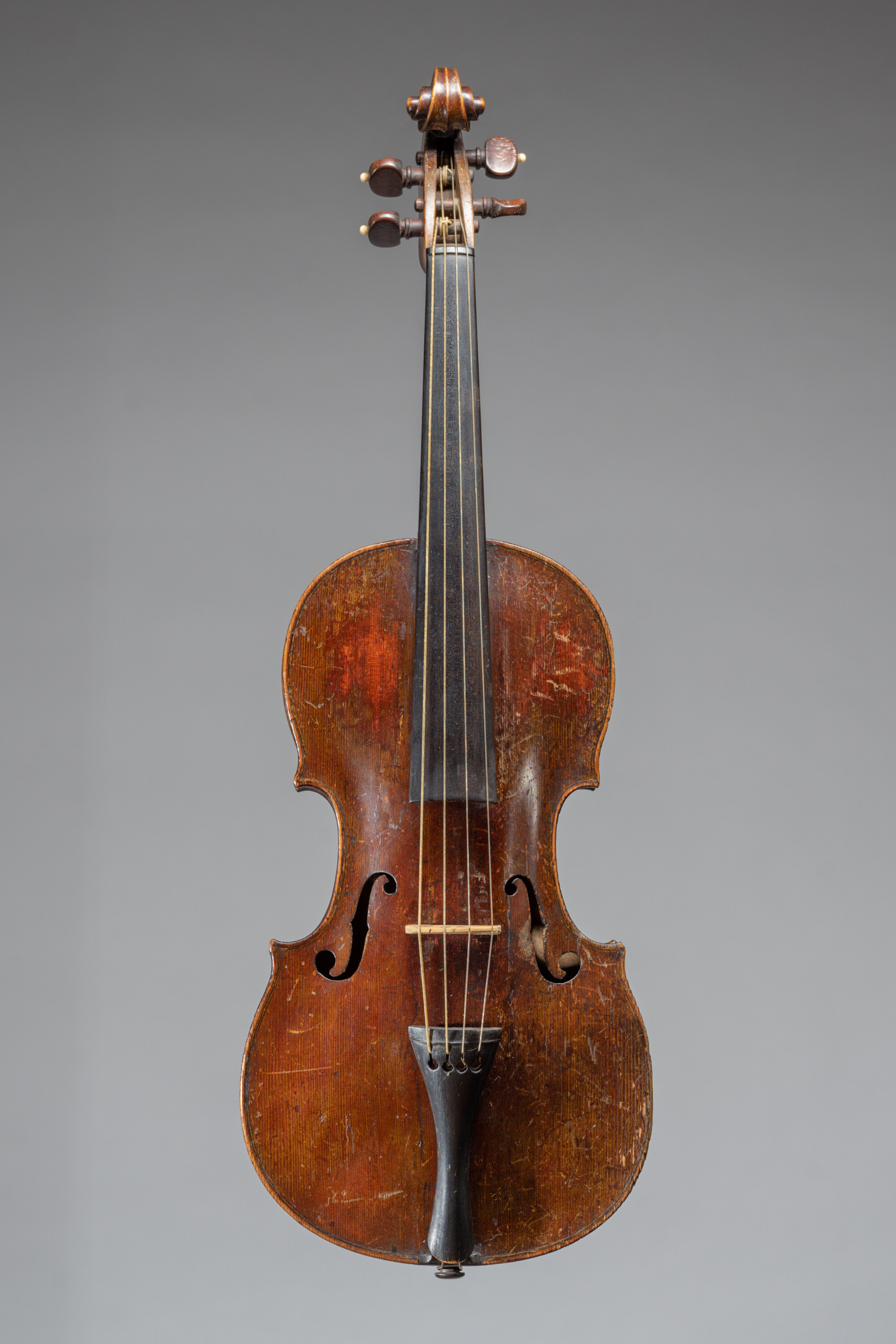 |
https://hudebninastroje.nm.cz/img/E_428-preview-1.jpg | https://hudebninastroje.nm.cz/img/E_428-preview-2.jpg | https://hudebninastroje.nm.cz/img/E_428-preview-3.jpg | https://hudebninastroje.nm.cz/img/E_428-preview-4.jpg | https://hudebninastroje.nm.cz/img/E_428-preview-5.jpg | https://hudebninastroje.nm.cz/img/E_428-preview-6.jpg | |||||
| 4 | Antonín Buchtel’s collection of musical instrument | E 430 | VIOLIN | Bernard Wutzelhofer (1789–1861) | Brno | 1822 | The violin is modelled after François Chanot with characteristic features: a guitar-shaped body (without corners); the top and back plates do not extend beyond the ribs; the soundholes are in the shape of a simplified letter “S”; the scroll twists backwards. The two-piece top plate is spruce, and the one-piece back plate is gently flamed maple. The ribs and neck are maple. The spirit varnish is brown. The fingerboard is ebony. The four tuning pegs are ebony, and two have circular nacre tips. Four steel strings are fastened to the tailpiece embedded in the top plate. | paper label printed and partially handwritten (year, numbering) with the inscription: “Nach chanotischer Art | verfertigt von | Bernard Wutzelhofer | in Brünn. | Im Jahr 1822 | I/3, No. 10.” | total length: 581 mmbody length: 360 mmbody width: upper 166 mm, middle 116 mm, lower 207 mmrib height: 32 mmstring length: ca. 320 mmneck stop length: 129 mmbody stop length: ca. 180 mmfingerboard length: 255 mm total length of soundholes: 100 mm upper span of soundholes: 65 mm | spruce (top plate), maple (back plate, ribs, neck), ebony (fingerboard, tailpiece), steel (strings), nacre (middles of the pegs) | The Brno luthier Bernard Wutzelhofer (1789–1861) was an apprentice of his father Sebastian Wutzelhofer and of the Brno luthier Ignaz Andreas Wild. In 1822/23 he made 13 violins based on Chanot’s invention. He is regarded as Brno’s best luthier. | Unpublished: ANM-RNM: carton 27, 1873–1874, delivered on 31 May 1874, no. 63 (letter, Antonín Buchtel to the Committee of the Museum of the Kingdom of Bohemia, 22 May 1874).Published:[ROZKOŠNÝ, J. R.]: P. Antonína Buchtla vzácná sbírka hudebních nástrojů. Hudební listy, 1872, Vol. 3, No. 17, pp. 138–140;PAUL, Oscar: Die musikalische Abtheilung der Wiener Weltausstellung. Leipziger Zeitung, 11. 9. 1873, no. 73, pp. 437–438;BUCHNER, Alexander: Průvodce výstavou české hudební nástroje minulosti v břevnovském klášteře sv. Markéty. Praha: Národní muzeum, 1950;KELLER, Jindřich: Sólo pro dva mistry (o hudebních nástrojích). Praha: Albatros, 1982, p. 98;ŽŮRKOVÁ, Tereza – KOTAŠOVÁ, Daniela – ŠTEFANCOVÁ, Dagmar – SLAVICKÝ, Tomáš: Antonín Buchtel, sběratel s laskavou duší, a jeho kolekce hudebních nástrojů / Antonín Buchtel, A Collector with a Kind Soul, and His Collection of Musical Instruments. Praha: Národní muzeum, 2021. | The instrument was on display at the 7th Industrial Exhibition in Prague in 1872 and at the World’s Fair in Vienna in 1873. In his report for the exhibition in Vienna, Oscar Paul called it a “plaything” with a function that was more decorative. This, however, is a sonically full-fledged experimental type of violin made by François Chanot (1788–1825), who had it patented in 1817. In Buchtel’s list, the following comment is added for this instrument: “Described in the journal Leipziger allgem. musik. Zeitung” – this involves the article: SIEVERS, G. L. P. Ueber die neuverbesserten Geigeninstrumente des Herrn Chanot. Allgemeine musikalische Zeitung, 9 Feb. 1820, vol. 22, no. 6, cols. 85–91. | 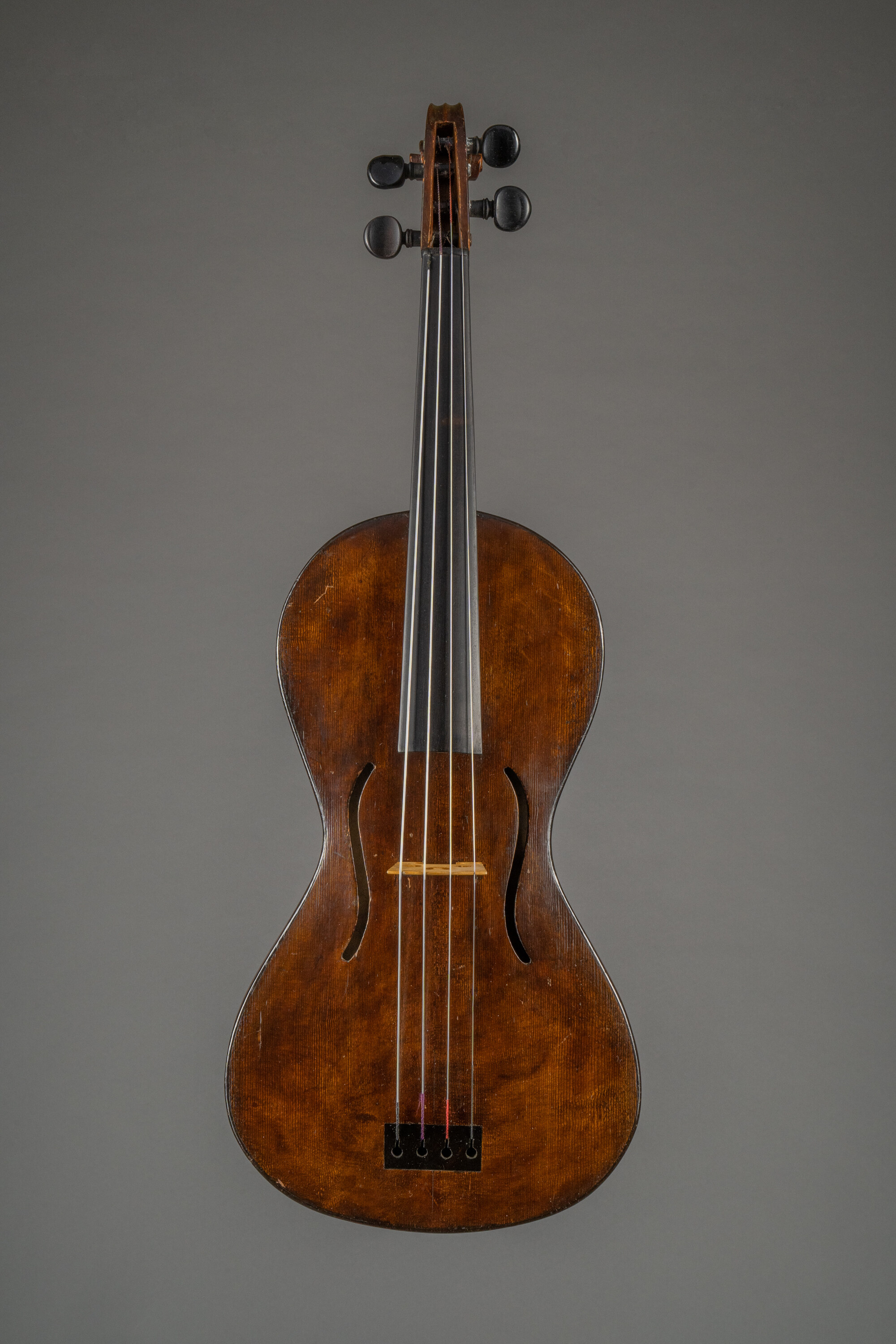 |
https://hudebninastroje.nm.cz/img/E_430-preview-1.JPG | https://hudebninastroje.nm.cz/img/E_430-preview-1.JPG | https://hudebninastroje.nm.cz/img/E_430-preview-3.JPG | https://hudebninastroje.nm.cz/img/E_430-preview-4.JPG | https://hudebninastroje.nm.cz/img/E_430-preview-5.JPG | https://hudebninastroje.nm.cz/img/E_430-preview-6.JPG | https://hudebninastroje.nm.cz/img/E_430-preview-7.JPG | ||||
| 5 | Antonín Buchtel’s collection of musical instrument | E 429 | VIOLIN | Unknown | unknown | latter half of the 19th century (before 1872) | The narrow body has an unusual design with a very narrow upper part and without C-bouts and upper corners. The varnish is dark brown. The two-piece top plate is spruce, and the one-piece back plate, ribs, and neck are flamed maple. The soundholes on the top plates are flame shaped. There is purfling on the top and back plates. The fingerboard is painted black. The tailpiece is pear wood. The end button is boxwood with a black centre. At the end of the peg box is a scroll. The neck is fitted to the body in the Baroque manner. The eight tuning pegs are made of dark wood with nacre centres. There are four melodic strings and four resonating strings running under the fingerboard. The resonating strings are fastened by nails in the bottom rib above the end button. | paper label with an illegible handwritten inscription (according to the historical records, now missing) | total length: 632 mm body length: 346 mm body width: upper 88 mm, middle 110 mm, lower 198 mm rib height: 20 mm at the neck, 23 mm in the middle, 24 mm at the end buttonstring length: ca. 313 mmneck stop length: 123 mmbody stop length: ca. 186 mmfingerboard length: 250 mm total length of soundholes: 66 mm upper span of soundholes: 55 mm | spruce (top plate), maple (back plate, ribs, neck), pear wood (tailpiece), boxwood (end button), dark wood (fingerboard, tuning pegs), nacre (tips of tuning pegs), gut (string, tailgut), steel (strings) | Some strings are missing. A paper label with the maker’s signature is apparently missing (the place inside the body where the original label was attached is visible). | Unpublished:ANM-RNM: carton 27, 1873–1874, delivered 31 May 1874, no. 63 (letter, Antonín Buchtel to the Committee of the Museum of the Kingdom of Bohemia, 22 May 1874).Published:[ROZKOŠNÝ, J. R.]: P. Antonína Buchtla vzácná sbírka hudebních nástrojů. Hudební listy, 1872, Vol. 3, No. 17, pp. 138–140;ŽŮRKOVÁ, Tereza – KOTAŠOVÁ, Daniela – ŠTEFANCOVÁ, Dagmar – SLAVICKÝ, Tomáš: Antonín Buchtel, sběratel s laskavou duší, a jeho kolekce hudebních nástrojů / Antonín Buchtel, A Collector with a Kind Soul, and His Collection of Musical Instruments. Praha: Národní muzeum, 2021. | In the journal Hudební listy and Buchtel’s list the instrument is called a “Mozartean violin”. It has an experimental body shape probably invented in the latter half of the 19th century, but before 1872 (when it is recorded in the journal Hudební listy). These experiments with new shapes for string instruments climaxed in 1880–1890. The instrument was on display at the 7th Industrial Exhibition in Prague in 1872 and probably also at the World Exhibition in Vienna in 1873. | 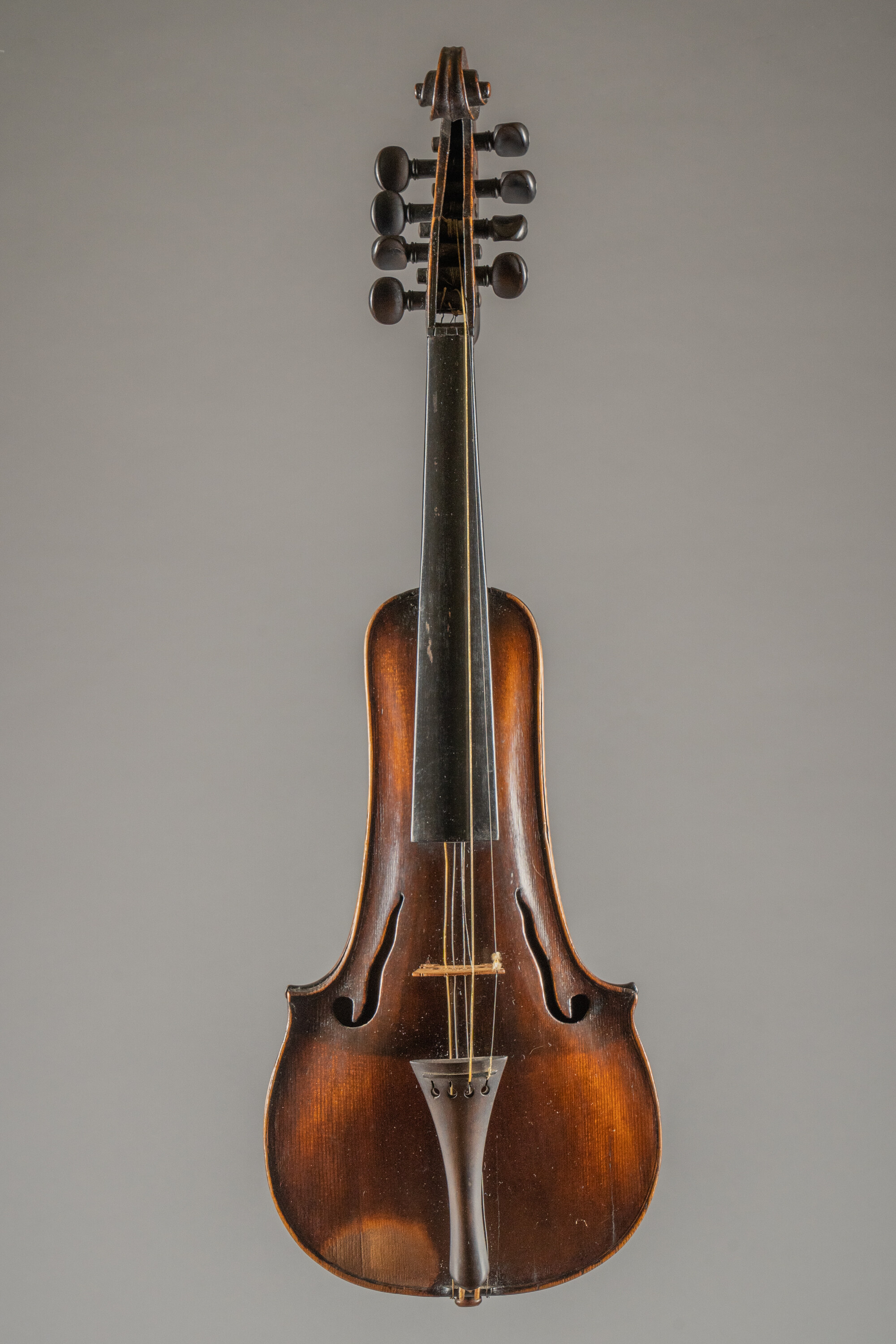 |
https://hudebninastroje.nm.cz/img/E_429-preview-1.JPG | https://hudebninastroje.nm.cz/img/E_429-preview-2.JPG | https://hudebninastroje.nm.cz/img/E_429-preview-3.JPG | https://hudebninastroje.nm.cz/img/E_429-preview-4.JPG | https://hudebninastroje.nm.cz/img/E_429-preview-5.JPG | https://hudebninastroje.nm.cz/img/E_429-preview-6.JPG | https://hudebninastroje.nm.cz/img/E_429-preview-7.JPG | ||||
| 6 | Antonín Buchtel’s collection of musical instrument | E 436 | PHILOMELE | Johann Georg Stauffer (1778–1853) | Wien / Vienna | 1829 | This unusually shaped bowed string instrument has four steel strings. The top is spruce, and the one-piece back plate, ribs, and neck are maple. Both plates are arched. The corners are of the shape found on viols. The varnish is orange. There is purfling on the top and back plates. The rib of the lower bouts is made of a single piece of wood. The soundholes are shaped like a slightly bent “C” with notches in the middle. The neck is fitted to the body in the modern manner. There is a scroll at the end of the peg box. The fingerboard, tailpiece, saddle, nut, and end button are ebony. The four tuning pegs are ebony with nacre centres. | paper label with the handwritten text: “Johann Georg Stauffer | in Wien. Anno 1829.” | total length: 602 mmbody length: 368 mmbody width: upper 165 mm, middle 109 mm, lower 193 mmrib height: at the neck 29 mm, in the middle 29 mm, at the end button 30 mmstring length: 312 mmneck stop length: 130 mm body stop length: 181 mmfingerboard length: 250 mm total length of soundholes: 88 mm upper span of soundholes: 101 mm | spruce (top plate), maple (back plate, ribs, neck), ebony (fingerboard, tailpiece, tuning pegs, nut, end button), steel (strings), gut (tailgut), nacre (tips of the tuning pegs) | The original tailpiece is missing: ebony, decorated with inlaid nacre roses, and the edges of the holes decorated with nacre, with a recessed brass fret above the holes (according to the historical records). | Johann Georg Stauffer (1778–1853) was originally a trained cabinetmaker, and he did his apprenticeship as a luthier under Franz Geissenhof (1754–1821). He became renowned during his lifetime as an excellent maker of guitars. From 1820 his interest diverted to making violins and to experimenting with instruments and inventing (including a violin modelled after Chanot, a guitar with two necks, and arpeggiones). | Unpublished:ANM-RNM: carton 27, 1873–1874, delivered on 31 May 1874, no. 63 (letter, Antonín Buchtel to the Committee of the Museum of the Kingdom of Bohemia, 22 May 1874).Published:[ROZKOŠNÝ, J. R.]: P. Antonína Buchtla vzácná sbírka hudebních nástrojů. Hudební listy, 1872, Vol. 3, No. 17, pp. 138–140; PAUL, Oscar: Die musikalische Abtheilung der Wiener Weltausstellung. Leipziger Zeitung, 11. 9. 1873, no. 73, pp. 437–438;ŽŮRKOVÁ, Tereza – KOTAŠOVÁ, Daniela – ŠTEFANCOVÁ, Dagmar – SLAVICKÝ, Tomáš: Antonín Buchtel, sběratel s laskavou duší, a jeho kolekce hudebních nástrojů / Antonín Buchtel, A Collector with a Kind Soul, and His Collection of Musical Instruments. Praha: Národní muzeum, 2021. | The instrument was on display at the 7th Industrial Exhibition in Prague in 1872 and at the World’s Fair in Vienna in 1873. In his report for the exhibition in Vienna, Oscar Paul called it a “plaything” with a function that was more decorative. This experimental instrument dates from about the middle of the 19th century (apparently originally from Munich). It was disseminated among amateur musicians and players of the bowed zither. In general, the development of this instrument is related to fashionable trends of the first half of the 19th century for the conversion of plucked instruments with fingerboards into bowed instruments (e.g. bowed zithers, Bogenguitarre, arpeggiones etc.). The instrument is also called a Filomena (Philomela/Philomena), and its German name is Stahlgeige. The word “filomela” also means “nightingale”, and that is probably how the instrument got its name. | 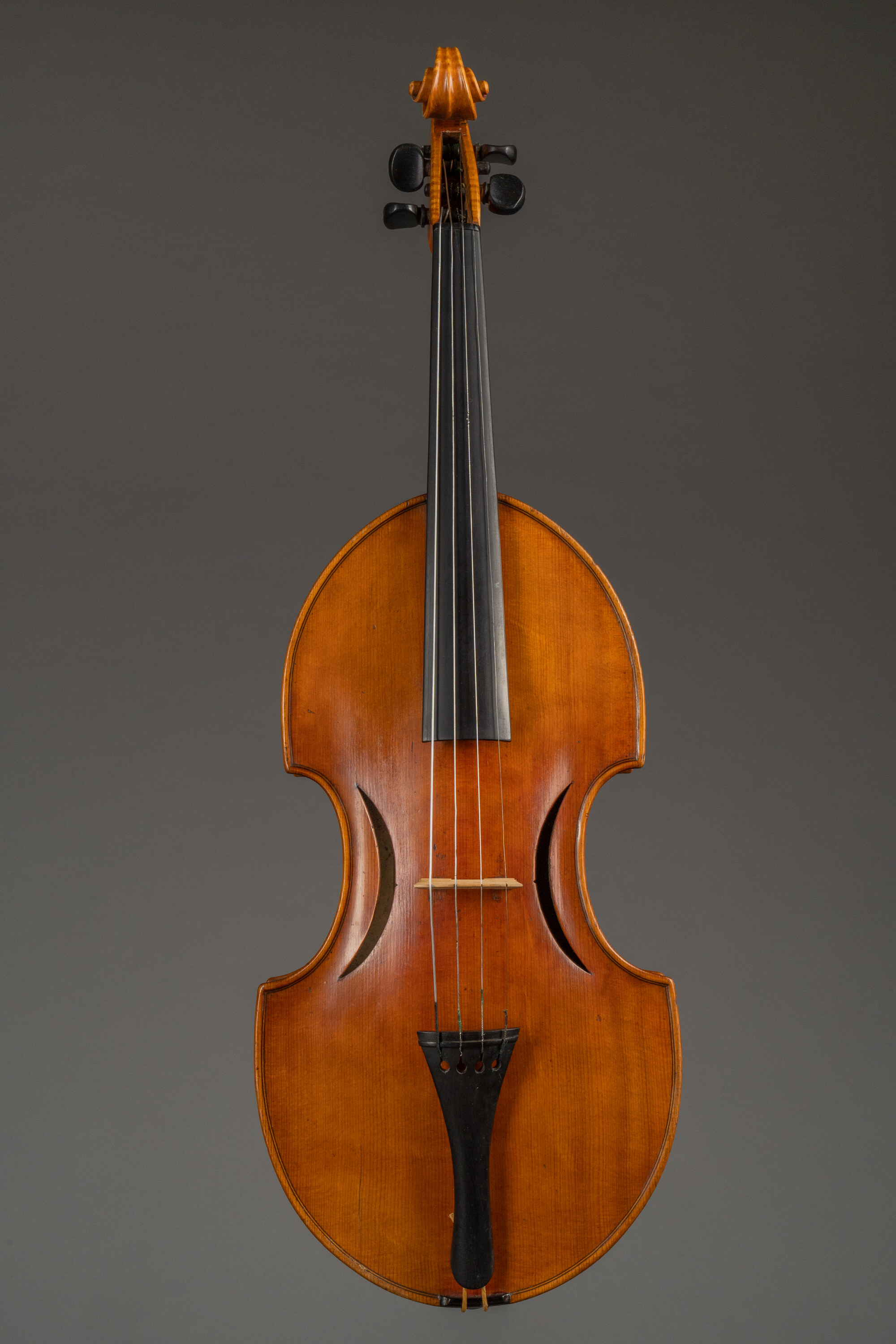 |
https://hudebninastroje.nm.cz/img/E_436-preview-1.JPG | https://hudebninastroje.nm.cz/img/E_436-preview-2.JPG | https://hudebninastroje.nm.cz/img/E_436-preview-3.JPG | https://hudebninastroje.nm.cz/img/E_436-preview-4.JPG | https://hudebninastroje.nm.cz/img/E_436-preview-5.JPG | https://hudebninastroje.nm.cz/img/E_436-preview-6.JPG | https://hudebninastroje.nm.cz/img/E_436-preview-7.JPG | |||
| 7 | Antonín Buchtel’s collection of musical instrument | E 431 | VIOLIN WITH A HORN | (?) Michael Ignaz Stadlmann (ca. 1746–1813) | (?) Wien / Vienna | (?) 1715 | The body has brown varnish. The top plate is spruce, and the back plate, ribs, and neck are maple. Both the top and back plates are arched and made of two pieces. There is purfling on the top and back plates. The instrument has F-holes. The neck is fitted to the instrument in the Baroque manner. The wedge-shaped fingerboard is made of spruce with an ebony veneer. The peg box ends with a scroll. The tuning pegs are made of dark wood with nacre tips. Inside the body there is a coil of brass tubing. The lead pipe for a mouthpiece juts out from the ribs on the lower bout at the site of the end button, and a bell in the form of an oval opening exits the body of the violin at the upper right bout. | Label with the inscription: “Michael Ignatius Stadlmann, kaiserl. königl Hof-Lauten- und Geigenmacher in Wien 1715” (according to the list of instruments in the journal Hudební listy, now missing) | total length: ca. 605 mm (without the mouthpiece)body length: 358 mm body width: upper 160 mm, middle 110 mm, lower 200 mm rib height: 32.5 mmstring length: ca. 323 mmneck stop length: ca. 128 mmbody stop length: 193 mmfingerboard length: 257 mm total length of soundholes: 70 mm upper span of soundholes: 33 mmø of the lead pipe: 7 mmdimensions of the bell: (oval) ca. 90 × 24 mm | spruce (top plate, fingerboard), maple (back plate, ribs, neck), ebony (fingerboard veneer), dark wood (tuning pegs), brass (metal tube), nacre (decorative tips of the tuning pegs) | One tuning peg, the tailpiece (decorated with a small circle made of nacre), and the funnelled mouthpiece (documented in the historical records) are missing. | The instrument may have been made by Michael Ignaz Stadlmann (ca. 1746–1813), who was a Viennese maker of violins and lutes and the son of the court luthier Johann Joseph Stadlmann (cf. cat. no. 12). He was a member of the Viennese court ensemble as a bass player. | Unpublished:ANM-RNM: carton 27, 1873–1874, delivered on 31 May 1874, no. 63 (letter, Antonín Buchtel to the Committee of the Museum of the Kingdom of Bohemia, 22 May 1874).Published:[ROZKOŠNÝ, J. R.]: P. Antonína Buchtla vzácná sbírka hudebních nástrojů. Hudební listy, 1872, Vol. 3, No. 17, pp. 138–140;PAUL, Oscar: Die musikalische Abtheilung der Wiener Weltausstellung. Leipziger Zeitung, 11. 9. 1873, no. 73, pp. 437–438;BAUER, František: Potštýnské zátiší a výletní místa v jeho okolí. Praha: Jos. R. Vilímek, [1892], p. 166;KURFÜRST, Pavel: Hudební nástroje. Praha: Togga, 2002, p. 843;ŽŮRKOVÁ, Tereza – KOTAŠOVÁ, Daniela – ŠTEFANCOVÁ, Dagmar – SLAVICKÝ, Tomáš: Antonín Buchtel, sběratel s laskavou duší, a jeho kolekce hudebních nástrojů / Antonín Buchtel, A Collector with a Kind Soul, and His Collection of Musical Instruments. Praha: Národní muzeum, 2021. | The instrument was on display at the 7th Industrial Exhibition in Prague in 1872 and at the World’s Fair in Vienna in 1873. Oscar Paul referred to it as follows: “Also worth mentioning from Buchtel’s collection is Stadlmann’s violin with a horn (1715). Although it looks like a plaything, this violin, in which a horn is visible through the soundholes, must be mentioned. In it we find a parallel to the ancient Oriental shawm, i.e. a violintype instrument, the mouthpiece of which is located very similarly at the head of the tailpiece like the horn mouthpiece on Stadlmann’s violin with a horn. In general, the Oriental department can easily show us that we are originally indebted to the Orient for everything that relates to music. After all, it is the task of history to point out the bridges that link us to ancient times (…).” M. I. Stadlmann is also mentioned as the author of this instrument in the list of Buchtel’s collection in the journal Hudební listy. However, the given year of manufacture (1715) does not fit with the maker’s dates of birth and death, but it is possible that the dating was misread from the label. After it was transferred to the museum’s collection, the instrument was designated as anonymous, and its authorship remains unclear because the paper label with the maker’s signature is now missing. | 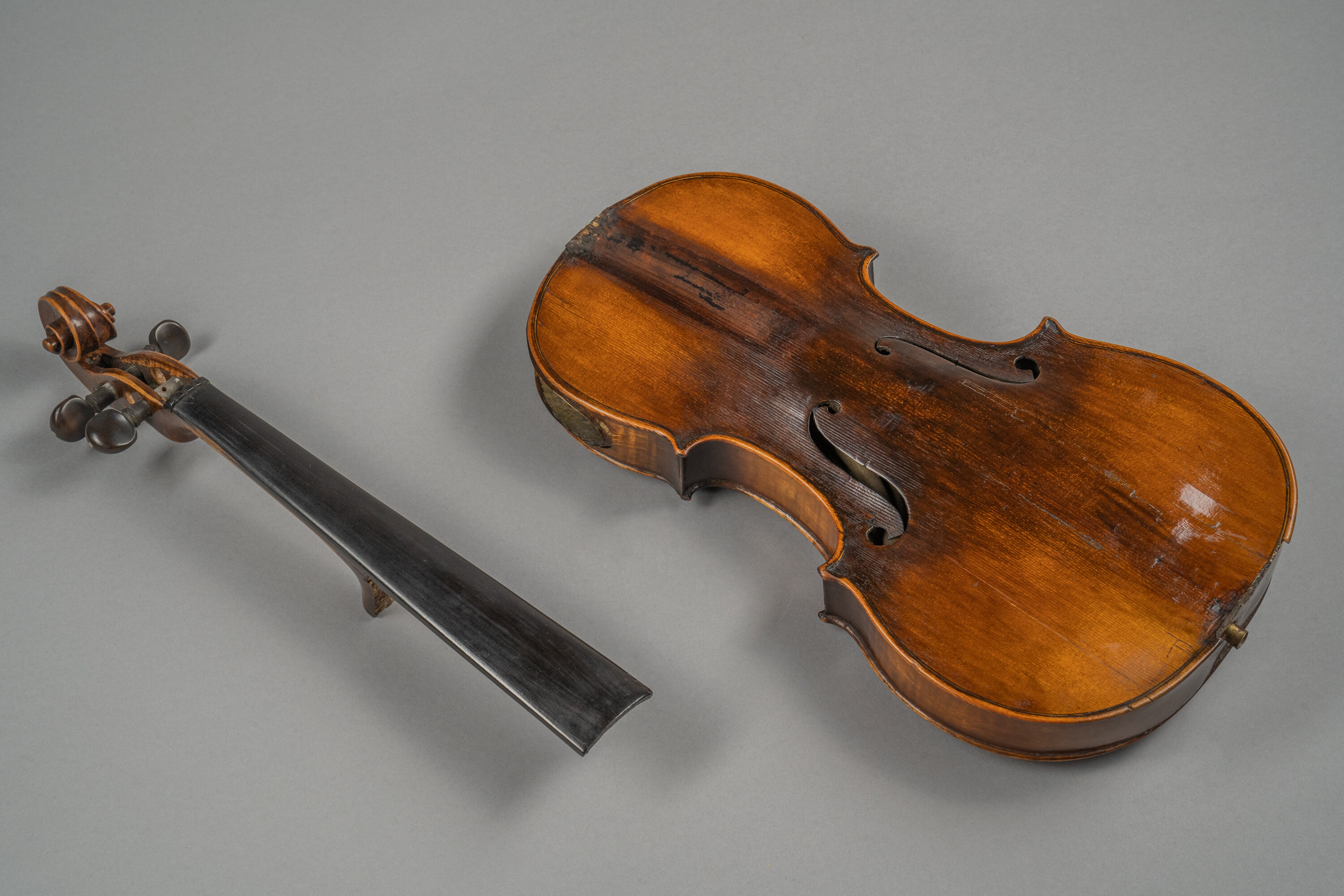 |
https://hudebninastroje.nm.cz/img/E_431-preview-1.JPG | https://hudebninastroje.nm.cz/img/E_431-preview-2.JPG | https://hudebninastroje.nm.cz/img/E_431-preview-3.JPG | https://hudebninastroje.nm.cz/img/E_431-preview-4.JPG | https://hudebninastroje.nm.cz/img/E_431-preview-5.JPG | https://hudebninastroje.nm.cz/img/E_431-preview-6.JPG | https://hudebninastroje.nm.cz/img/E_431-preview-7.JPG | https://hudebninastroje.nm.cz/img/E_431-preview-8.JPG | https://hudebninastroje.nm.cz/img/E_431-preview-9.JPG | |
| 8 | Antonín Buchtel’s collection of musical instrument | E 433, NpM: A 7760 | VIOLIN MADE OF A NAUTILUS SHELL | (?) Jakob Kliment (I.) (1811–1893) | Brno | ca. 1850–1873 | The body is made from the shell of a marine cephalopod from the family Nautilidae. The top is made of spruce. Attached to the bottom part of the body is a round tailpiece made of ebony, which also serves as a chinrest. The fingerboard is made of ebony with 25 copper-nickel frets and six nacre position markers. The headstock is flat and angled towards the back, and there are four tuning pegs and a geared tuning mechanism with knobs made of white bone. There are four steel strings. The violin bridge is maple. There are two oblong soundholes. The top plate is painted silver with coloured prints portraying Chinese men and women and with parrots on tree branches. The edges of the top plate and of the soundholes are decorated with black and red lines and rows of dots. | total length: 458 mmtop plate length: 195 mmtop plate width: 96 mmbody depth: 99 mmstring length: 290 mm length of soundholes: 47,2 mmupper span of soundholes: 40 mmø of the tailpiece: 60 mm | shell (body), spruce (top plate), ebony (tailpiece, fingerboard, neck, headstock, end button), maple (bridge), brass (tuning mechanism), copper-nickel (frets), white bone (tuning knobs), nacre (position markers on the fingerboard, button on the end button), steel (strings) | Jakob Kliment (I) (1811–1893) was a weaver who later did his apprenticeship in Brno with Heinrich Arlow then took over his workshop in 1864. He then taught the trade to other family members. He was also a master baryton maker, and he worked on experimental forms of instruments – he invented a kind of bowed zither or “table violin”. | Unpublished:ANM-RNM: carton 27, 1873–1874, delivered on 31 May 1874, no. 63 (letter, Antonín Buchtel to the Committee of the Museum of the Kingdom of Bohemia, 22 May 1874).Published:PAUL, Oscar: Die musikalische Abtheilung der Wiener Weltausstellung. Leipziger Zeitung, 11. 9. 1873, no. 73, pp. 437–438;BAUER, František: Potštýnské zátiší a výletní místa v jeho okolí. Praha: Jos. R. Vilímek, [1892], p. 166;ŽŮRKOVÁ, Tereza – KOTAŠOVÁ, Daniela – ŠTEFANCOVÁ, Dagmar – SLAVICKÝ, Tomáš: Antonín Buchtel, sběratel s laskavou duší, a jeho kolekce hudebních nástrojů / Antonín Buchtel, A Collector with a Kind Soul, and His Collection of Musical Instruments. Praha: Národní muzeum, 2021. | The instrument was on exhibit at the World’s Fair in Vienna in 1873, where Oscar Paul called it “a modern imitation of a Chinese violin made of a mollusc shell by Jacob Kliment from Brno” (“eine von Jacob Kliment in Brünn angefertigte moderne Nachahmung der chinesischen Muschelgeige”). On the basis of this information and of the information stated in Buchtel’s own list of objects from the donated collection, the Brno luthier Jakob Kliment should be the instrument’s maker, but the maker’s signature has not been found on the available parts of the instrument. | 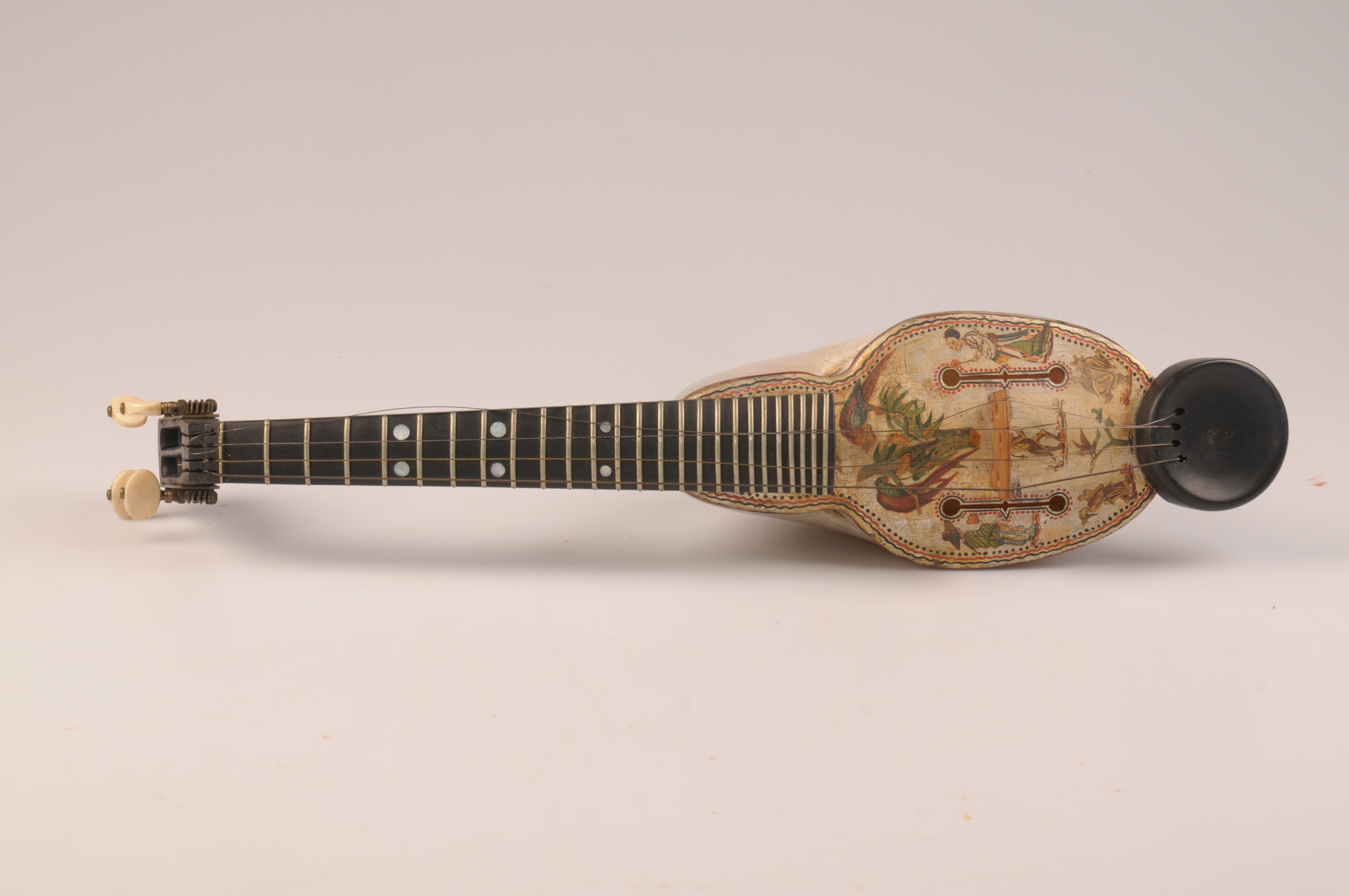 |
https://hudebninastroje.nm.cz/img/E_433-preview-1.JPG | https://hudebninastroje.nm.cz/img/E_433-preview-2.JPG | https://hudebninastroje.nm.cz/img/E_433-preview-3.JPG | https://hudebninastroje.nm.cz/img/E_433-preview-4.jpg | https://hudebninastroje.nm.cz/img/E_433-preview-5.JPG | https://hudebninastroje.nm.cz/img/E_433-preview-6.JPG | ||||||
| 9 | Antonín Buchtel’s collection of musical instrument | E 432 | MINIATURE VIOLIN + BOW | Anonymous | unknown | 19th century | Violin: an instrument of miniature dimensions. The top plate is spruce, and the back plate, ribs, and neck are maple. The varnish is faintly yellow. The back plate, ribs, and neck are made of a single piece of wood. The purfling is painted on. The F-holes are of the standard shape. The fingerboard and tailpiece are made of dark wood, and the four tuning pegs are stained brown. The peg box ends with a scroll. The gut strings are stretched through two openings in the tailpiece. The end button is made of light-coloured wood. The tailgut is made of gut string.Bow: slightly concave, red varnish. The frog is made of light-coloured, unvarnished wood. The screw has a brass ridge for tightening the horsehair with a steel wire. | Violin:total height: 143 mmbody length: 85 mmbody width: upper 35 mm, middle 23 mm, lower 44 mmrib height: 9 mmBow:total stick length: 158 mmheight (frog + stick): 11 mmstick diameter: 3.5 mm at the frog, 3.3 mm in the middle, 2.2 mm at the tip | spruce (top plate), maple (ribs, back plate, neck), unidentified lightcoloured wood (end button, frog, tuning pegs, bow stick), unidentified dark-coloured wood (fingerboard, tailpiece), gut (strings, tailgut), horsehair | Bridge missing. | Unpublished:ANM-RNM: carton 27, 1873–1874, delivered on 31 May 1874, no. 63 (letter, Antonín Buchtel to the Committee of the Museum of the Kingdom of Bohemia, 22 May 1874.Published:ŽŮRKOVÁ, Tereza – KOTAŠOVÁ, Daniela – ŠTEFANCOVÁ, Dagmar – SLAVICKÝ, Tomáš: Antonín Buchtel, sběratel s laskavou duší, a jeho kolekce hudebních nástrojů / Antonín Buchtel, A Collector with a Kind Soul, and His Collection of Musical Instruments. Praha: Národní muzeum, 2021. | Buchtel himself called the instrument “Tiny violin as a joke”. | 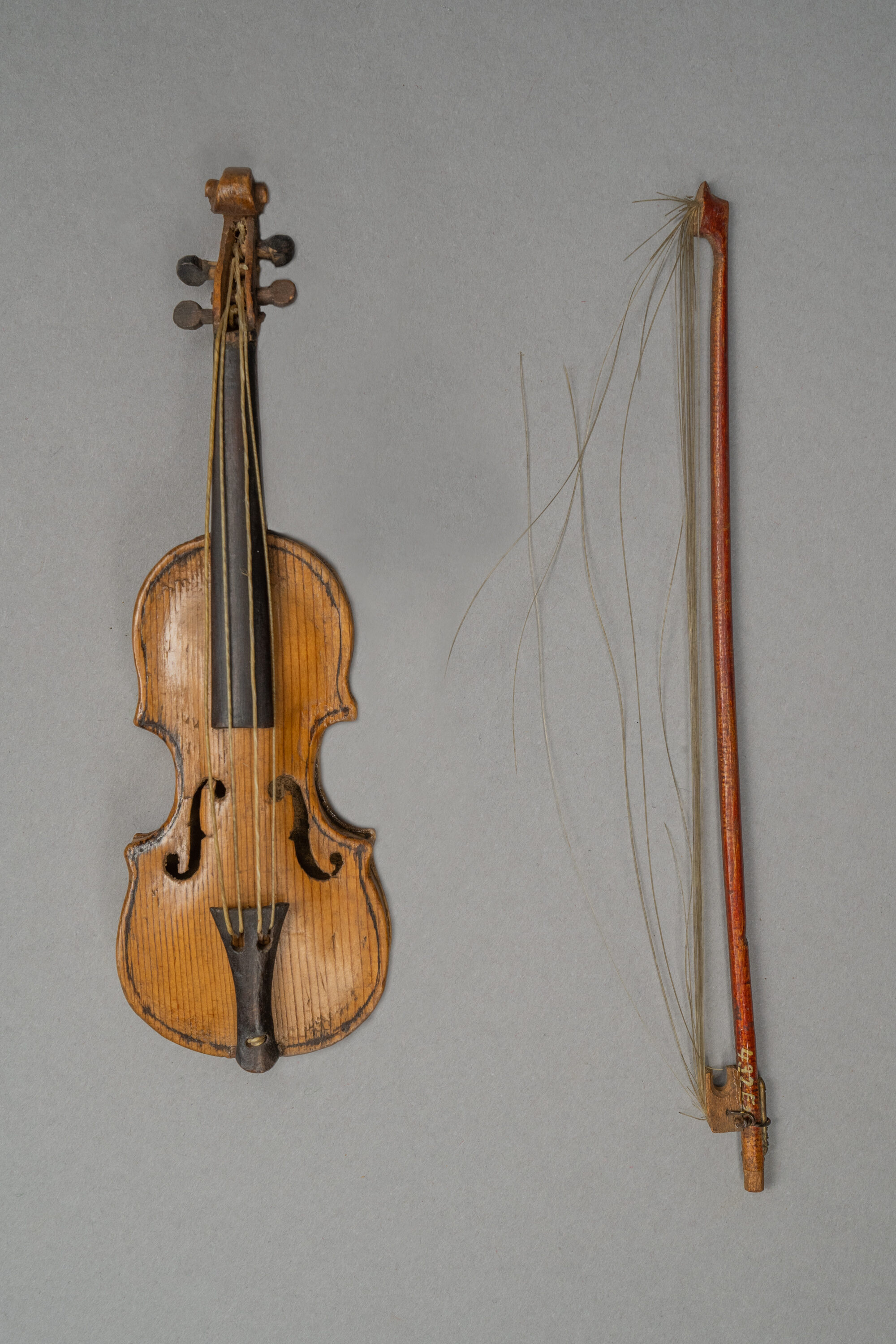 |
https://hudebninastroje.nm.cz/img/E_432-preview-1.JPG | https://hudebninastroje.nm.cz/img/E_432-preview-2.JPG | https://hudebninastroje.nm.cz/img/E_432-preview-3.JPG | https://hudebninastroje.nm.cz/img/E_432-preview-4.JPG | https://hudebninastroje.nm.cz/img/E_432-preview-5.JPG | |||||||
| 10 | Antonín Buchtel’s collection of musical instrument | E 435 | VIOLA + BOW | Nicolaus Leidolff (before 1673–ca. 1710) | Wien / Vienna | 1700 | Viola: The body has decorative indentations. The two-piece top plate is spruce and the two-piece back plate is maple. There is purfling on the top and back plates. The tailpiece and fingerboard are ebony. The soundholes are wide, slightly bent, and shaped like those found on old viols. The varnish is golden brown. The peg box ends with a carved human head. The four tuning pegs are rosewood with nacre tips. Bow: The varnish is dark red. The tip is extended with a strip of ivory. The frog is ebony with inlaid nacre and white metal. | paper label with the handwritten inscription: “Nicolaus Leidolff / | in Wien / 1700.” | Viola:total length: 689 mmbody length: 414 mmbody width: upper 195 mm, middle 125 mm, lower 228 mmrib height: at the neck 35 mm, in the middle 33.5 mm, at the end button 35 mmstring length: 360 mmneck stop length: 146 mmbody stop length: 213 mmfingerboard length: 285 mm total length of soundholes: 89 mm upper span of soundholes: 74 mmBow:total length: 715 mm | spruce (top plate), maple (back plate, ribs, neck), ebony (tailpiece, fingerboard, frog), rosewood (tuning pegs), nacre (inlay in the tuning pegs and the bow frog), ivory (strip in the bow tip) | The edge of the top plate has been repaired around the entire perimeter. A wedge has been inserted at the heel to change the neck angle. The bow is missing – eliminated from the collection on 19 April 1952. | Nicolaus Leidolff (before 1673–ca. 1710) was a luthier of Swiss origin and the founder of a family of luthiers who worked in Vienna and Graz. In 1696 he was a founding member of the Vienna luthiers’ guild. | Unpublished:ANM-RNM: carton 27, 1873–1874, delivered on 31 May 1874, no. 63 (letter, Antonín Buchtel to the Committee of the Museum of the Kingdom of Bohemia, 22 May 1874).Published:[ROZKOŠNÝ, J. R.]: P. Antonína Buchtla vzácná sbírka hudebních nástrojů. Hudební listy, 1872, Vol. 3, No. 17, pp. 138–140;PAUL, Oscar: Die musikalische Abtheilung der Wiener Weltausstellung. Leipziger Zeitung, 11. 9. 1873, No. 73, pp. 437–438;CULKA, Zdeněk – RUTOVÁ, Milada – KELLER, Jindřich – ŠERÝCH, Jaroslav: Muzeum hudebních nástrojů. Katalog stálé expozice hudebních nástrojů hudebního oddělení Národního muzea v Praze. 2nd ed. Praha: Národní muzeum, 1973, p. 24;ČÍŽEK, Bohuslav: Hudební nástroje evropské hudební kultury. Praha: Aventinum, 2002, p. 72;ŽŮRKOVÁ, Tereza – KOTAŠOVÁ, Daniela – ŠTEFANCOVÁ, Dagmar – SLAVICKÝ, Tomáš: Antonín Buchtel, sběratel s laskavou duší, a jeho kolekce hudebních nástrojů / Antonín Buchtel, A Collector with a Kind Soul, and His Collection of Musical Instruments. Praha: Národní muzeum, 2021. | The instrument was on display at the 7th Industrial Exhibition in Prague in 1872 and at the World’s Fair in Vienna in 1873. The descriptions of the bow and its dimensions are based on historical records; the bow is no longer part of the collection. | 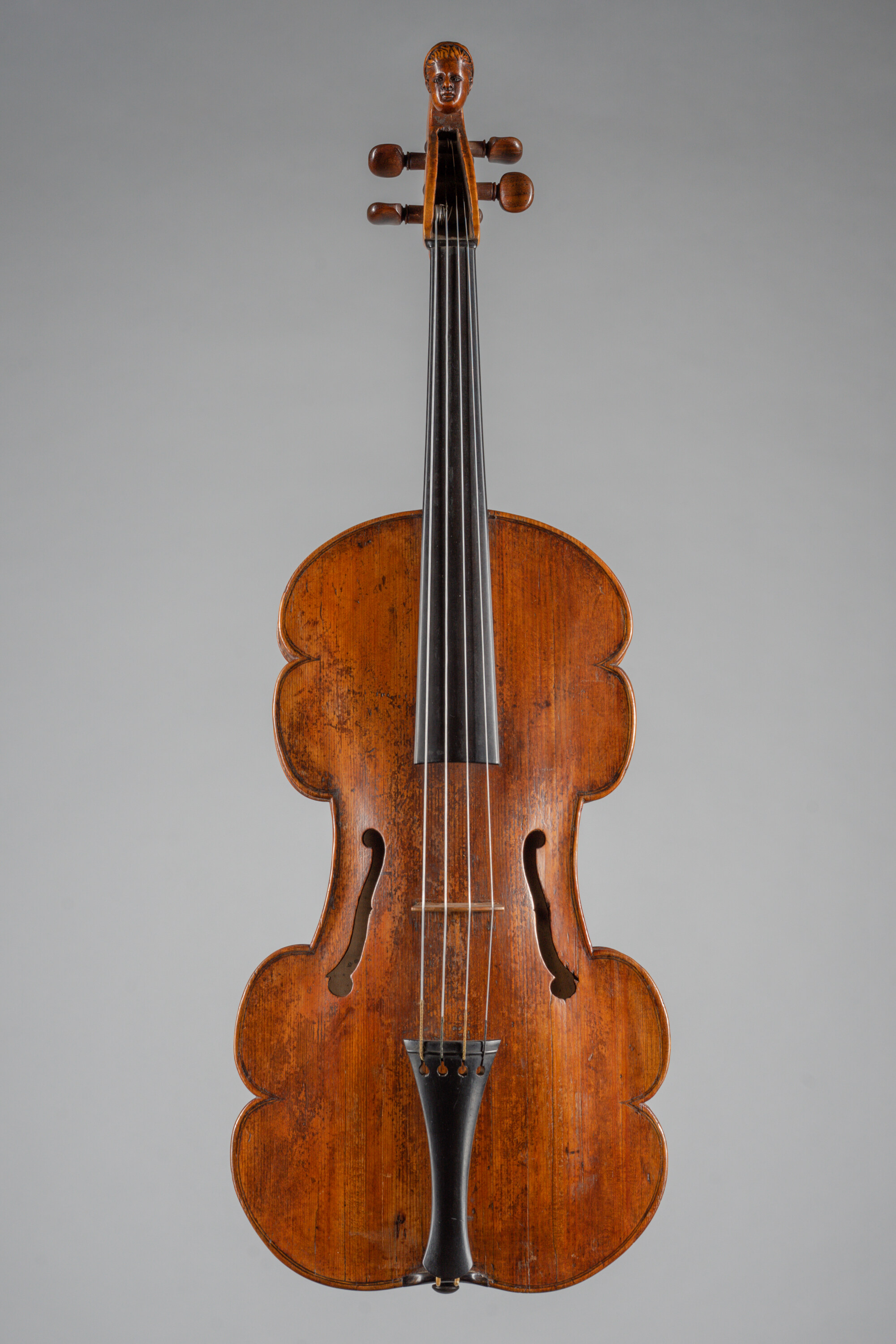 |
https://hudebninastroje.nm.cz/img/E_435-preview-1.jpg | https://hudebninastroje.nm.cz/img/E_435-preview-2.jpg | https://hudebninastroje.nm.cz/img/E_435-preview-3.jpg | https://hudebninastroje.nm.cz/img/E_435-preview-4.jpg | https://hudebninastroje.nm.cz/img/E_435-preview-5.jpg | https://hudebninastroje.nm.cz/img/E_435-preview-6.jpg |
id:
Collection:
Inventory n.:
Name of the instrument:
Maker:
Place of manufacture:
Dating:
description:
signature:
dimensions:
material:
condition:
maker_info:
references:
comments:
Image:
fig_1:
fig_2:
fig_3:
fig_4:
fig_5:
fig_6:
fig_7:
fig_8:
fig_9:
fig_10:
